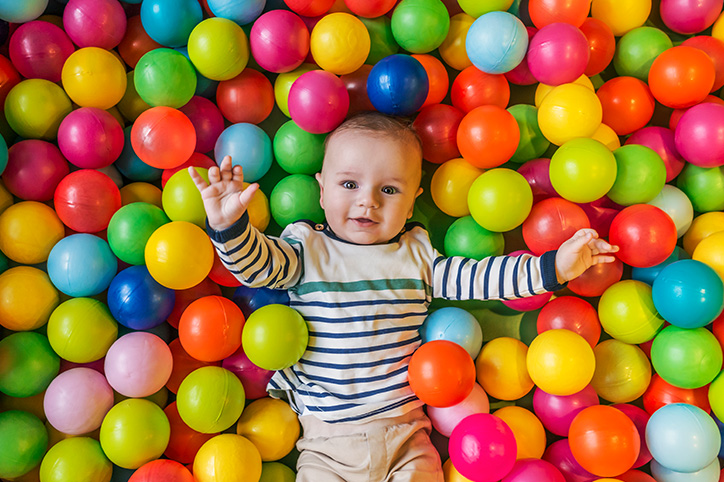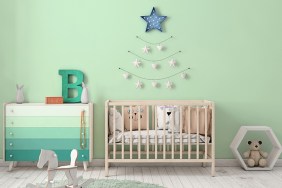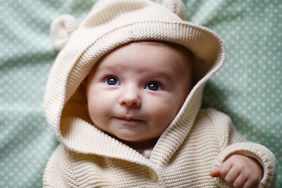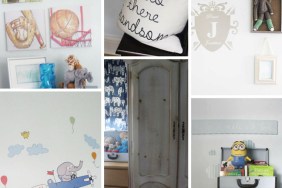Even in this age of gender fluidity there are some hard-held associations that most of us have with specific colors. You don’t typically see parents painting their newborn boy’s room neon pink or their girl’s room black. But did you know that colors go beyond aesthetics and can actually have a great impact on our mood and that of our children?
“Colors affect people in different ways, which is largely based on their past experiences, cultural references and innate responses to color,” says Andrea Magno, the director of color marketing and development at Benjamin Moore. “For an adult, there are many more experiences and associations that contribute to the way we feel about a given color, and sometimes the way people feel about colors stems from childhood.”
For babies, during their first few months of life they don’t see an array of colors, rather they see the world in variations on white, gray and black. “Because of how limited the colors that babies see are, contrasts are especially important since it’s something they’re able to perceive and it helps stimulate their minds,” says Magno. “Once babies move beyond the newborn stage they begin to see colors, particularly the primary colors of red, blue and yellow. As they grow their color preferences develop and, before you know it, they have a strong sense of their color likes and dislikes.”
While how adults and children perceive colors may vary slightly from one person to another, there are some generalizations that have been researched over many years that contribute to the moods associated with different hues. We asked Magno to highlight the main points, so you can have an easier time as you put together your kids’ rooms (or your own!).
Blue
“A color family often associated with tranquility, this is always a solid choice for painting a baby room – whether for a boy or a girl. Popular variations on blue that move away from the traditional ‘baby blue’ are Van Deusen Blue HC-156 or Down Pour Blue 2063-20. Some other great options include Cumulus Cotton 2063-70, Summer Shower 2135-60, Palladian BlueHC-144, or Harbor Fog 2062-70.”
Pink
“This is another soothing color for the walls of a baby’s room that will encourage relaxation. A few flattering pink options include Pink Bliss 2093-70, First Light 2102-70, or Pink Damask OC-72.”
Green
“With its connection to nature and ability to create a calm, balanced atmosphere, green is always popular, but more and more we see deeper greens being used in baby rooms for a look that is modern and sophisticated, but still calming for a baby. A range of great greens to consider are Silken Pine 2144-50, Hancock Green HC-117, or Cushing Green HC-125.”
Yellow
“Often associated with being warm and upbeat, the right shade of yellow can be enveloping and cheerful. However, be careful not to select a yellow that is too intense, which can create the opposite effect. A stronger yellow can be a fun addition as an accent, but as a wall color the softer variations on yellow will deliver a more pleasing result. A few soft yellows are Pale Moon OC-108, Ambiance 309, Hawthorne Yellow HC-4, and Weston Flax HC-5.”
Orange
“Orange is an energizing color that is often overlooked, but can serve as a fun accent color, especially when paired with it’s opposite on the color wheel – blue. Similar to yellow, bring in a citrusy orange with painted furniture or a small accent brings an upbeat wink of color to a room. A few fun orange options are Oriole 2169-30, August Morning 2156-40, or Soft Pumpkin 2166-40.”
Purple
“Another color that creates a sense of calm, purples are also associated with creativity. This is a great color family to consider for walls or accents, especially in areas devoted to arts and crafts. Some pretty purples are Hint of Violet 2114-60, Lavender Mist 2070-60, and French Lilac 1403.”
Gray
“Grays are very popular for nurseries as they are a color that is gender neutral, they have staying power from one age to the next, and they are great for bringing a wide array of colors as accents. Some favorite grays are Stonington Gray HC-170, Bunny Gray 2124-50, or Gray Owl OC-52.”
White
“A crisp canvas for any color, white is a perfect backdrop for creating contrasts that are stimulating for young minds, or for a soft and soothing space. White walls can also be a great backdrop for painted furniture or allow the many great baby accessories and toys be the colorful hero in the space. A few of our no-fail white paint colors are Chantilly Lace OC-65, Alabaster OC-129, or Simply White OC-117.”
Black
“This is a daring choice for a wall color, but when balanced with white or other pale colors it can make for a chic baby room, or even a play room where primary colors can be brought into the scheme as accents whether through artwork or furniture. A few black paint colors to consider are Black Beauty 2128-10 or Witching Hour 2120-30.”








